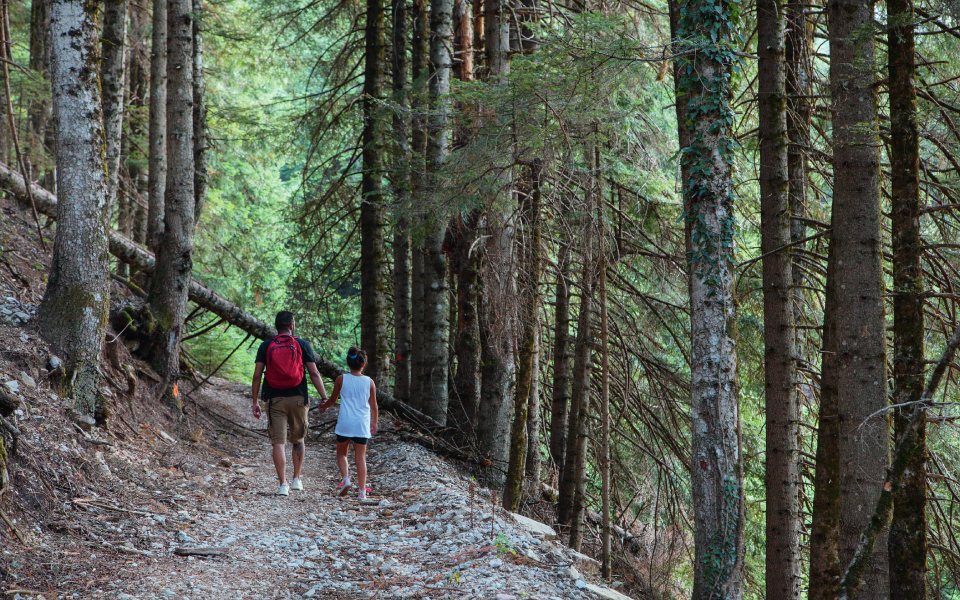“Do not top me up again, I’m driving,” I say to the gang in the café at Theodoriana, who are dead set on giving me more to drink. The older members of the group burst out laughing, and clink glasses with me once more. No, it is not their fine tsipouro that we are drinking, but a pitcher filled with water. The truth is that the one thing you will never buy in Tzoumerka is water, no matter how long you stay.
Water is naturally available everywhere, even in August, in the form of waterfalls, streams, springs, cascades. This water helps operate watermills and water presses, is bottled in state-of-the-art facilities, forms pools for swimming, and makes the locals build fonts and footbridges all over. The land is verdant, filled with plane trees bearing fruit and, as you look up the mountain side, fir trees interrupted by red tile roofs. If you look even higher, the setting takes your breath away – Tzoumerka is one of the most impressive mountains in Greece thanks to its sharp peaks, which surpass the 2000 meter mark.
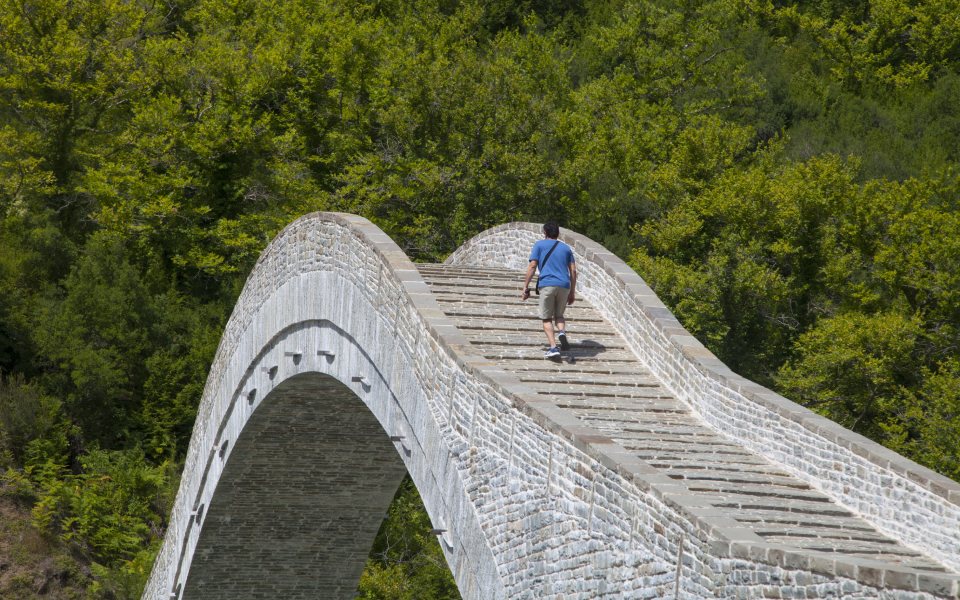
© Olga Charami
There are about 47 Tzoumerko villages in the area, spread across the districts of Arta and Ioannina. In the Arta villages, which we are visiting for the weekend, there are no old, stone-built houses. They were burned down during the German Occupation, as they were caught in the eye of the storm: an EDES (National Republican Greek League) headquarters, with the Resistance fighters right next door, in the mountains of Trikala. The allied British were in Theodoriana, while the Germans everywhere.
The distances are not particularly large, but you must take the endless turns and narrow roads into consideration – estimate double the time for each journey. You will come across villages with names that encourage puns and word games, animals and developed livestock farming, old ladies such as Mrs. Dimitra at Ramia, who carries boxes on her back without complaint, trees laden with fruits and people collecting them, stores with multiple uses, such as the shop at Athamanio that sells foodstuffs and building materials, as well as mountain refuges with young people ready to share the secrets of the mountain with you.
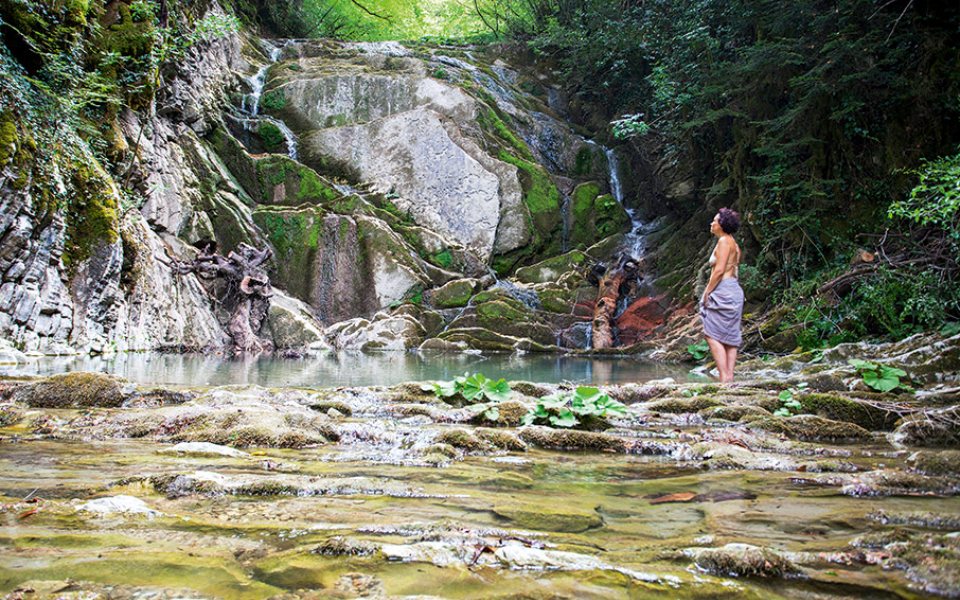
© Olga Charami
Eight stops in Central Tzoumerka
1. Doro Theou (God’s Gift) or Terma Theou (God’s End)?
Built at an altitude of 950 meters and nestled between three impressive mountain views, Katafidi (the highest peak in Tzoumerka at 2393 meters), Kriakoura and the mountains of Trikala, the village of Theodoriana may be just 15 kilometers from Athamanio, yet it seems completely isolated. Indeed it sometimes is, as the mountain pass at Stavros at an altitude of 1440 meters is blocked by snow in the winter. This is where the locals confronted the tsiflikades (feudal lords) in 1883 and claimed the famed Kostilata plateau, today a grazing ground for 5000 sheep, and property of the Mandatory Cooperative.
The water bottled here is called “Kostilata,” named after the spring that is just one of 50 natural springs in the area. Theodoriana is the water capital. You can drink from anywhere, and even take a dip: at the stone bridge at the end of the village, or Marks Stream, with its pools, is an ideal setting just 40 minutes away on foot. You can also refresh yourself at the famed Souda waterfalls, an impressive 25-meter cascade of waters that flow even in the summer months (15 minutes by foot).
You should also take a seat at one of the traditional cafes and listen to the stories of the locals: about the Melissourgiotes, whom they never meet because they are divided by Vitseli; about the Vlach farmers who come to the lowlands in the autumn; about the water-dams they are protesting against; and of course, about the diplokagelos, a special dance that represents the uprising against the tsiflikades (feudal lords).
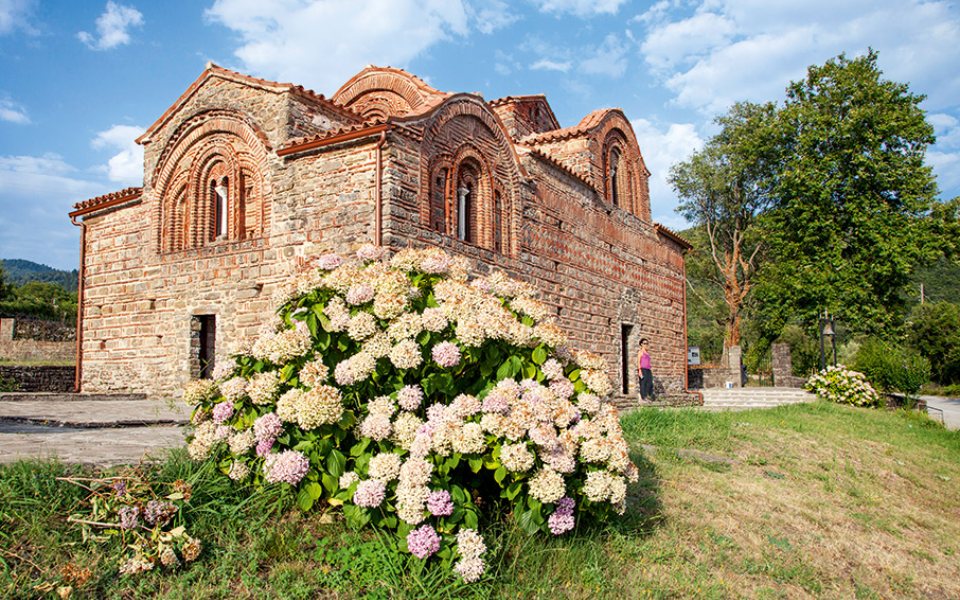
© Olga Charami
2. Vourgareli with an “r”
“Vourgarelimero” (Vourgareli with an “r”) repeats an old man sipping on his coffee in the village square, as if it would make a difference if it were spelled with an “l.” And yet, the presence of the letter “r” excludes any connection with the tsiflikades (great feudal lords) or lumberjacks from Bulgaria, and is a reference to a man named Vourgareli, a benefactor of this land. The details are not really that important. This is one of the most popular villages and houses the municipality’s headquarters. Enjoy a cup of coffee on the huge square with its enormous plane trees, take a walk through the narrow roads, fill your water bottles at the two stone fonts – Krystallo and Archonto.
Above the village is perched the Monastery of Agios Giorgos, from where chieftains Roumelis and Ipeirou declared the revolution at Tzoumerka, while below the village the Byzantine Red Church is located, featuring inlaid ceramic decorative details, while the Neraidogephyro (Fairy Bridge) is located nearby. Search for Kyttaro Technis Tzourmerkon (tel. 6979-912980), a creative arts collective that promotes cultural activities including a permanent exhibition of the great photographer Kostas Balafas, who hails from nearby Kypseli, as well as temporary photography and art exhibitions.
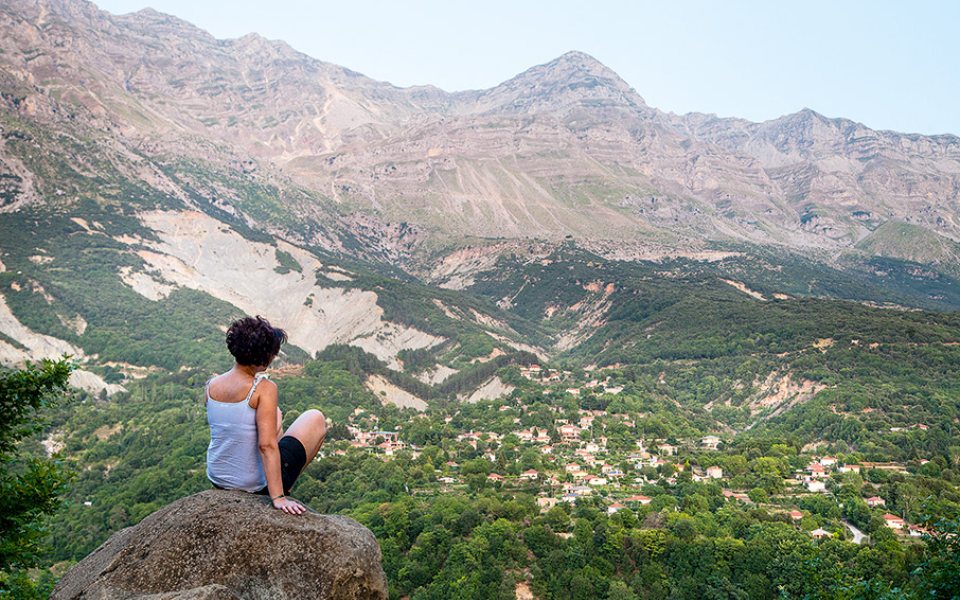
© Olga Charami
3. Where did the waterfall go?
Residents of Kataraktis village (“waterfall” in Greek) feel rather slighted: they have the most impressive waterfall (it is a double waterfall and falls from a height of 100 meters), yet it is dry in the summer and the autumn. Pay this village a visit and experience its lovely main square featuring plane trees, fonts and a church.
Heading up to the mountain refuge is also interesting, as it has had a new lease of life after being abandoned for so many years. The rough dirt road (road paving works are expected soon) will offer impressive views of the mountains and majestic views from an altitude of 1657 meters; if you want to visit the refuge, be sure to call first (tel. 6972-771295) as we were unable to communicate.
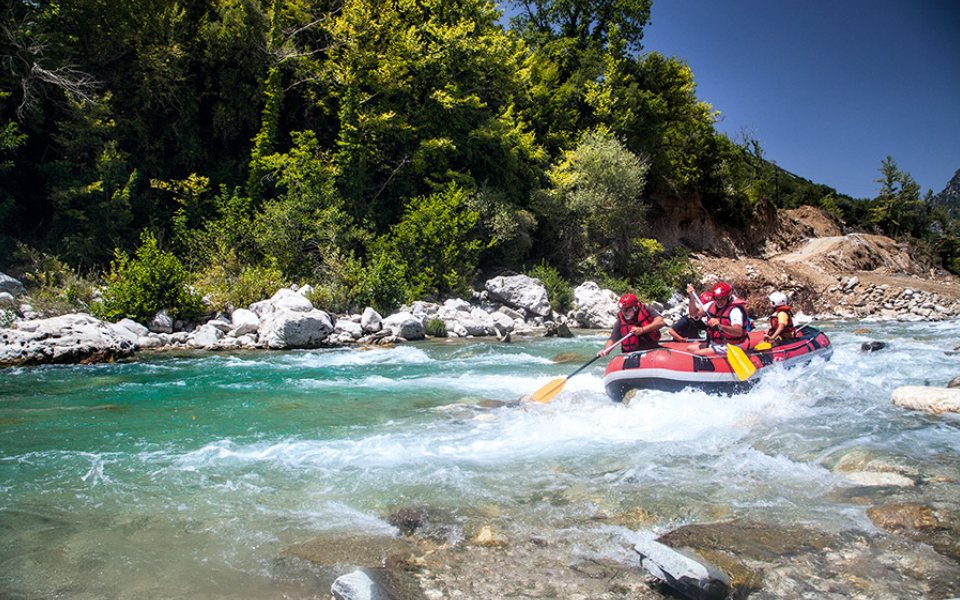
© Olga Charami
4. Sailing to Plaka
The most intense presence of water in the area is the Arachthos River. And the most beautiful site and stopping point is the Plaka footbridge, which collapsed in 2015 and was reconstructed just last year. No longer bearing the signs of time, but equally impressive, you can walk across the footbridge gazing at the emerald waters of the river below, or take a seat at the small café next to it: this used to be the custom house when the river formed the border between Greek and Turkish occupied Epirus (1881 – 1912). This is also where ELAS (Greek People’s Liberation Army) and EDES (National Republican Greek League) met in 1944 to sign a ceasefire. Finally, the footbridge marks the terminating point of a wonderful 10 kilometer rafting route that begins at the Politsa bridge.
Also recommended for novices, the river crosses springs, a waterfall and the Arachthos gorge (Active Nature, tel. 6937-667799).
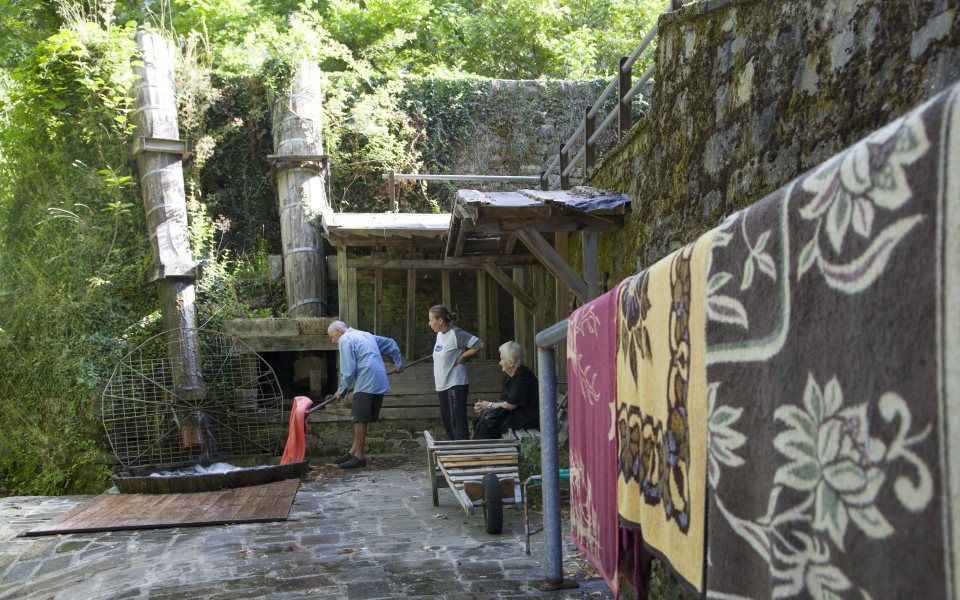
© Olga Charami
5. Laundry in Agnada
Agnada looks out on Xerovouni, but visitors can see the impressive Strogoula peak above it. A large village, Agnada features several stores and is rather bustling. You may stop for coffee or a bite to eat, walk through the winding streets or, even better… do your laundry! The whirlpool operates normally, as does the watermill, offering the best natural deep clean for blankets and flokatis (shaggy woolen rugs), using just the power of water – and in fact, at just 80 cents apiece! (tel. 6978-397643)
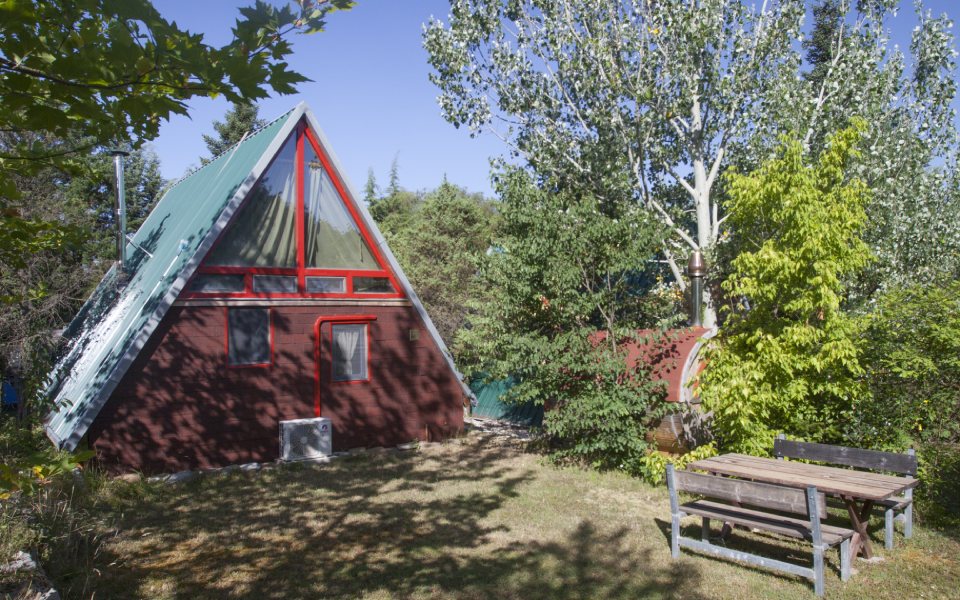
© Olga Charami
6. Sojourn at Ktistades
My window by the bed in the attic is a huge, perfect triangle. It frames a fir tree, an oak tree, low mountains and the moon. You can hear the crickets. Spending the night at Chalet Kalivas (tel. 6930-797829, tzoumerkakalivas.eu, from 100 euros) certainly is a special experience.
Two independent triangular houses, fully-equipped and incorporated into the natural environment on a 5 square kilometer expanse, featuring specially designed spaces for rest, playing ping pong, a barbecue, a special thermal spring in the ground, and a Jacuzzi and sauna for wellness. Theasis Igloo is located just next door (tel. 6948-682910, theasis-igloo.com, from 100 euros), with three equally special residences, rounded and pyramid-shaped with glass roofs, for endless hours of star gazing into the night. On the other side you will find Marina’s Stone Cottage (tel. 6986-232672, from 100 euros).
One cannot but wonder at how such special hospitality offerings can be found here, in Ktistades village. The answer can be found in the actions of three friends: Giorgos Kalivas, who designed them, Nikos Zapsas and Thomas Tatsionas, who decided to invest in the area.
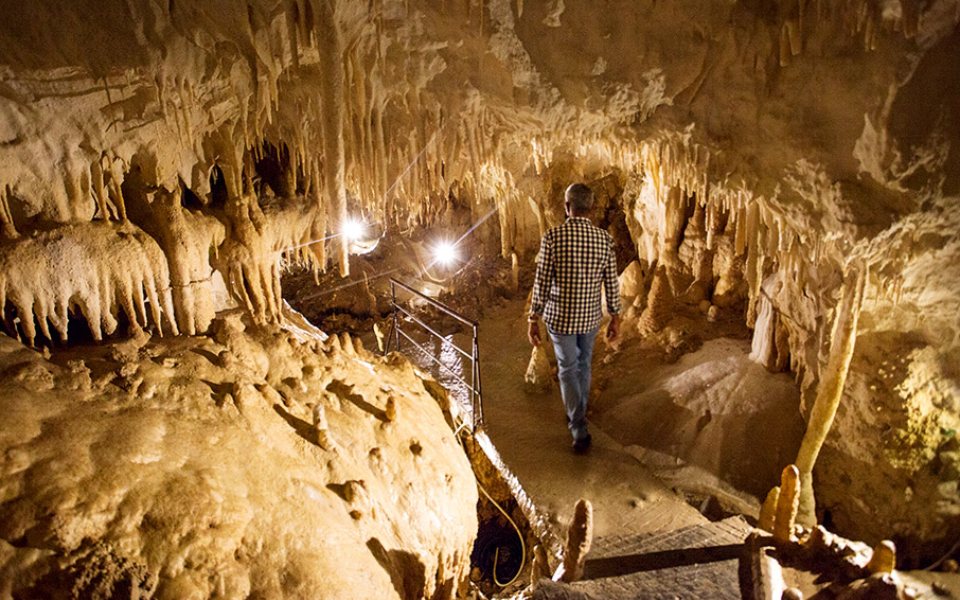
© Olga Charami
7. In the depths and on the slopes of Pramanta
Inside the Anemotrypa cave, just outside Pramanta, flows an underground river. Despite not being visible, its rumble takes your breath away. The route open to tourists measures 250 meters in length and passes through impressive caverns, adorned with natural limestone formations, which lead to a small lake. Experienced guide Manolis Sedeles explains the cave’s special characteristics, takes your picture and reveals all the cave’s secrets with his torch.
As illogical as it may seem due to its geographic location, Pramanta falls in the district of Ioannina and is the headquarters of the Municipality of North Tzoumerka. This is where you will find shops, tavernas and rooms to let, as well as an ATM and petrol station.
Just outside the village, the dirt road will lead you to the Pramanta refuge. A starting point for many wonderful hiking trails on Strogoula, this is the perfect base for hikers and mountaineers. Babis Triantafyllou and Pola Markozi settled here permanently 15 years ago, and recently renovated the refuge once more, offering hikers (and not only) exemplary hospitality with upgraded home-cooked meals, a wonderful seating area and a cooling down bath (sourced with water from the nearby waterfall), which most people mistake for (and use as) a children’s swimming pool.
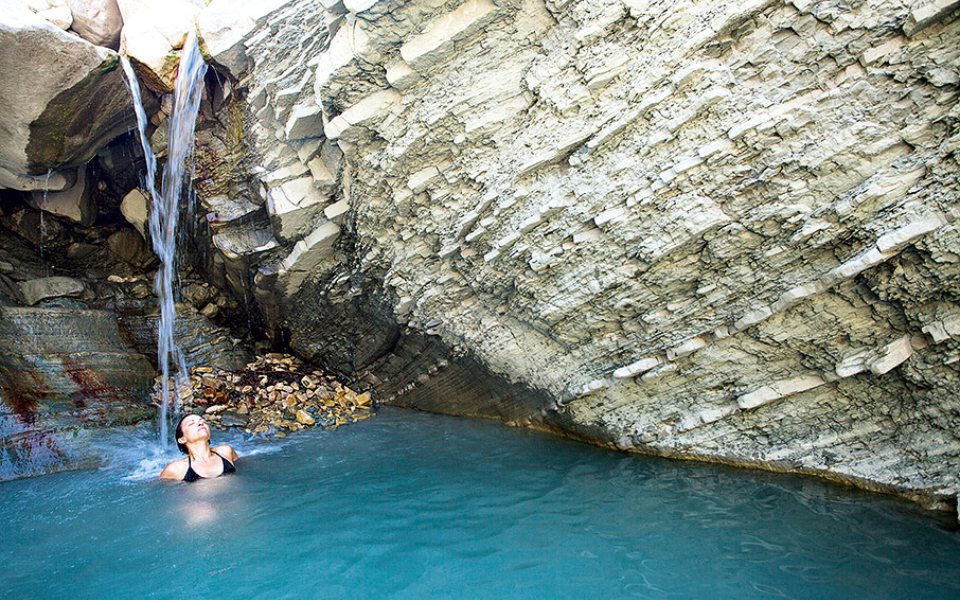
© Olga Charami
8. The end of the road at Melissourgos.
Most people have the summer panigyri (traditional festival) to remember from Melissourgos, a gathering point for more than 2000 visitors. Lately there is talk about the refuge that has recently been taken over by new ownership, bringing a sense of vibrancy to the village and the mountain. This is where the hiking trail begins (1 kilometer) towards Melissourgos waterfall. Water bubbles and flows all around you. Under the village, the water collects in natural pools, where you can have a swim.
Apart from that, it is worth making a stop at the Church of Agios Nickolas in the upper square. Surrounded by mountains and waters, this is the ultimate sense of isolation – this is also the end of the road.
Few locals tell stories about bears and wolves, celebrations and other random tales. Such as the time when the snow plough from Ioannina opened the road until Pramanta, leaving Melissourgos (which belongs to Arta) cut off. In retaliation, they cut off the water supply!

